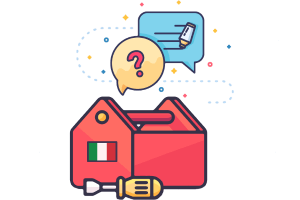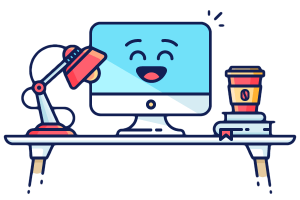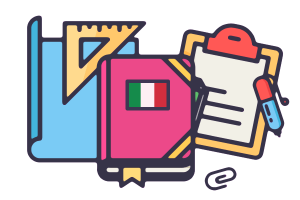The Italian Online Method
Discover the keys to learning Italian successfully that others don’t talk about!

We get this question a lot and to be completely honest there is no easy answer. The truth is that each one of us responds differently to different teaching methods and material. There are, however, ways that can help you get the most out of your learning efforts.
The approach we describe below is what we believe to be the best way to learn Italian, or any language for that matter. It will not tell you what specific language courses to buy or what textbook to use, but rather it will guide you through different steps that together can have a big impact on how we learn and how effectively we do it over time.
Our approach is based on 5 steps and is the result of years of experience in learning and teaching languages. The holistic and natural approach that this method offers allows you to learn effectively and successfully. Learning a new language is hard work and we are here to help you in this journey to make the best of it and to make sure you get to the finish line successfully!
The 5 Steps
 Additionally, the implementation of all steps results into a strong shield against excuses. Yes, you read that right, excuses are one of the biggest enemies in learning. “I’m not smart enough” or “it’s too difficult for me” are just a few examples of negative scripts we make up in our minds to justify our lack of progress. We want to transform those negative scripts into positive ones: “this is challenging but I can do it!” How do we do it?
Additionally, the implementation of all steps results into a strong shield against excuses. Yes, you read that right, excuses are one of the biggest enemies in learning. “I’m not smart enough” or “it’s too difficult for me” are just a few examples of negative scripts we make up in our minds to justify our lack of progress. We want to transform those negative scripts into positive ones: “this is challenging but I can do it!” How do we do it?


1. Motivation
The number one factor whether you will be successful at learning a language is: Motivation.
It doesn’t matter if you buy the most expensive learning course out there; you can have the best Italian learning material or the best Italian teachers in the world, but if you are not motivated to learn then you never will. The best indicator of success in learning a language (or anything for that matter) is how motivated you are as well as how motivated you remain throughout the learning process.
I have seen this many times, and I have experienced this myself as well. You start really excited about learning a language, you fantasize a bit about the things you will soon be able to do, you get one of those beautifully designed apps that promise you to be fluent in 3 months by playing little games and collecting points, then you fast forward three months and the only things you can say are hello, how are you? and thank you. You find yourself totally frustrated and hopeless. All that enthusiasm you had at the beginning is gone and you start giving up because you should’ve been fluent by now! At least that’s what the app promised, right? I feel your pain, been there, done that… multiple times.
The bright side is that we, at Italian Online, want you to succeed and have no interest in deceiving you by saying that you will become fluent in 3 months just so that we can sell a few more e-books or courses. That’s not who we are or what our mission is. We are the ones that will keep your feet on the ground, while at the same time keeping you motivated and entertained to continue in your learning journey and succeed!
So before making any learning decisions or plotting plans or strategies, let’s focus on our internal engine that will drive us to success.
Print out the Italian Online Learning Method or use your notepad if you prefer and write down first of all your main objective and then the reasons why you want to achieve that objective (what drives you). Try to be as specific as possible.
Hold on to that note as we move on to the second step. You will go back to it every time you feel discourage or like giving up. It will help you refocus and it will remind you all the good reasons why you are on this journey.
Before you move on to the next steps, take a few minutes to think about and write down your motivations for learning Italian:
- What are the reasons that made you decide to start this journey?
- What drives you to reach your goal?
- And finally, what do you hope to achieve in the end?

2. Toolbox
The tools are what will assist you and allow you to reach your goal. By tools we mean language courses, textbooks, one-on-one lessons, etc. This is where Italian Online excels at! You’ve guessed it, we have created all sorts of resources (tools) designed to help you in your journey. They come in the form of advice, e-books and audiobooks (Short Stories), and articles (Blog).
We understand that not everybody learns the same way or at the same pace, that’s why our material comes in all forms and shapes and we are confident you will find something that you will like.
The Essentials
To make sure our toolbox is complete, we need to add a variety of tools that are able to cover all necessities. Some tools are excellent for beginners and to set the foundations of our Italian knowledge, while with time some tools will become obsolete or “worn out” and we will need to make sure we replace them with up-to-date and current ones. The ideal Italian Toolbox will have the following tools, in this specific order:
- Base Language Course
- Real-Italian Exposure
- One-on-one Tutoring
- Grammar Based Textbook or Software
Base Language Courses
This tool is essential for all beginners as it lays the foundation and the initial understanding of the language. Knowing the very basic grammar rules is necessary to be able to understand and retain more complex information on top of that. Depending on your language level this tool might not be necessary. In fact, we recommend using these type of courses for the first 2-3 months of learning. Once a comfortable base level has been established, it is time to transition to the next tools which will help us increase our learning exponentially.
To find a list of available courses, please take a look at our page with the Best Italian Learning Resources.
Real-Italian Exposure
To be able to understand and speak Italian we need to be exposed to it so we can get used to it and comfortable with it. You could know all of the grammar rules by heart, but if you are not used to hearing the real spoken language, the likelihood is that you won’t be able to understand it anyway. The reason is that a language cannot be taught, but it can only be learned and the only way to do that is to be exposed to it constantly.
Italian Online has a very diverse collection of resources that will expose you to the real Italian that is spoken in Italy today. The ultimate goal is to help you understand songs, books, and movies in Italian; to be able to converse with ease without being afraid of making mistakes. We recommend using these resources daily as they allow you to absorb the real spoken language and will make you learn more than you can imagine.
To find all of our resources, please check out our Learn section.
Another amazing platform is RaiPlay. Rai is the Italian Public Broadcasting company, analogous to PBS or BBC, and it recently created this on-demand portal where all Italian residents can enjoy their favorite programming. It goes without saying that by watching the streams you will be exposed to what Italians watch every single day, plus the quality of the shows is exceptional. The only catch is that the vast majority of the stream are country restricted, which means that they can only be accessed in certain countries. So which shows you will be able to see depends on the country you live in, there are obviously ways to circumvent country restrictions such as VPNs, but it is not our place to discuss about those things.
One-on-One Tutoring
Understanding is a great start, it will boost your confidence and will make you feel awesome, but that’s only half of the cake! To finish the job, we need to be able to communicate effectively with others. The reason why one-onone tutoring is only third in the list is because you need that confidence and self-conviction that comes with the previous tool: real Italian exposure. Starting conversations too soon might kill your confidence and enthusiasm, because it might expose deficiencies and discourage us from continuing with our learning journey. One-on-one tutoring can also become expensive and the last thing we want to do is waste money on it when we are not ready yet. In fact, most professional tutors charge between $20-50/hour, and we recommend an hour of tutoring per week.
Tutoring can be an insurance against giving up, because when you have lessons booked in once a week, you have to show up and it will hold you accountable as well as help you remain motivated when times get rough.
We only have very limited one-on-one tutoring spots that fill up very quickly, but need not to worry because there are many valid tutoring resources out there. A service we recommend is iTalki, with them you will have the 9 opportunity to pick the tutor you like the most. Price ranges can vary greatly, for that reason it is important to be mindful about the fact that not all tutors are native speakers and/or professional teachers.

3. Planning
I remember my coach in college always repeating the famous phrase by Benjamin Franklin when speaking to us as a team: “By failing to prepare, you are preparing to fail.” In some sense this also holds true when learning a language. If you do not prepare (or plan) your learning journey, the likelihood of you succeeding is not very high. Planning and preparation lie at the base of many things and they enable us to break down complex and arduous things into small bits that suddenly become not only more manageable, but also achievable.
Life will get in the way of even our very best intentions and in order to be successful, we need to be prepared by defeating excuses and setting ourselves up for success. How do we do that? Simple, by setting aside learning time into our busy everyday schedules.
This step almost seems so obvious that it becomes laughable, but the truth is that if we do not have a clear game plan on how to learn this language, the language will kick our naïve little butts. So what are some simple guidelines that can enable us to be successful at this?
- Develop the right plan for you
- Set up a recurring time to dedicate to focused learning
- Improvise
- Reflect and Recalibrate
Develop the right plan for you
We are all different, some people love the details and intricate plans while others thrive in organized chaos and freedom. There is no right or wrong plan, only the one that fits you. The important thing is to develop a plan that is right for you and that will motivate you to keep going. So take out the notes you wrote in the first step regarding your motivation and keep into consideration those aspects when scheduling things.
It is necessary to be brutally honest with oneself. If you are a night owl, don’t tell yourself that you are going to wake up 30 minutes earlier each morning to practice Italian. It probably won’t happen and you will just get discouraged. Whatever your personality, your strengths and your weaknesses, develop your plan around them. Make it as easy as possible for you to succeed.
Set up a time
With the previous point in mind, schedule a time to study Italian. It might be every day during lunch break. It might be 20 minutes each morning or before bedtime. It might be in the coffee shop at 5.15pm every Monday, Wednesday, and Friday. Whatever it is, set the times and do it. In your plan, put down small points that you can accomplish every week. They should be specific and achievable. Develop the discipline and take those steps every time, which will move you closer to your ultimate goal.
Improvise
This is my favorite point, because it’s like a bonus. Throughout the day we often find ourselves idling or waiting for something – these are great opportunities to do some passive learning by listening to some Italian songs, an audiobook or reading a book in Italian. The key is to prepare yourself ahead of time in case situations like these arise. For example, prepare a playlist of your favorite songs on your smartphone, load some ebooks on your portable device. Next time you are waiting for your doctor’s 12 appointment don’t waste time playing Candy Crush, spend that time on improving your Italian!
Reflect & Recalibrate
Take a few minutes at the end of each day to reflect on some of the things you have learned in your active and passive learning sessions. What are some things that felt easy and that you liked? What are others that you found challenging and not so enjoyable? Be mindful of this feedback and use it to your advantage by recalibrating your plan and schedule if needed. Remember, the goal is to always remain positive and feel motivated when learning Italian.
Here is an example of what a learning schedule would look like:


4. Method
I do not believe that a language can be learned without passion, commitment, and hard work. As you might have noticed already, I loathe all those websites or services that advertise false promises like “become fluent in Italian in 3 months with just 15 minutes a day.” It sells great, but it doesn’t work that way and you shouldn’t be expecting those type of results. Our brain needs time to absorb the language, process it, and finally be able to speak it.
What results can you expect?
Well, it depends on your starting level together with the time and effort you decide to invest into learning Italian. Our recommendation, in order to see consistent results, is 30-60 minutes of practice every day. Becoming fluent requires years of practice, especially if you don’t live in the country where the language is spoken. However, if you were to dedicate 60 minutes every day to learning for six months, I would expect you to be competent enough to follow the radio and understand enough of a movie to actually enjoy it.
We base our method on the process originally discovered by Professor Stephen Krashen. It is known as Theory of Second Language Acquisition and it is based on 5 hypotheses. The great part about it is that it doesn’t focus around grammar, so no need to spend countless hours on boring lessons or exercises!
Here is a brief explanation of each of the 5 hypotheses:
1. Acquisition vs. Learning
Professor Krashen believes that there are two main ways to learn a language: you can learn it or you can acquire it. When you learn a language, you are consciously trying to retain information, for example studying the grammar rules. While when you acquire a language, your subconscious processes the information similarly to children acquiring their first language.
Surprisingly, when we are consciously learning a language, like focusing on its grammar rules for example, the information we assimilate does not get absorbed by our subconscious, which makes remembering what we are trying to learn really difficult. Instead, it is a lot more efficacious to learn a language subconsciously. How do we do that? By exposing ourselves to the right inputs.
2. Input
For our brain to efficiently process a new language we need to expose it to an adequate amount of quality input, that is reading and listening. This input needs to be comprehensible yet slightly above our current skill level. It should be challenging enough to make us feel engaged, but not too much to feel intimidated or frustrated.
Additionally, the comprehensible input needs to be in line with our personal interests. If we love detective stories, why force ourselves to read a romantic book we don’t actually enjoy? That’s why at ItalianOnline we have created a broad portfolio of material to suit different personal interests and learning styles. Once we have found material that we enjoy then we need to make sure we expose ourselves to it every day, just like we did as children with our native language. To see all of our learning material click here.
3. Monitor
As we grow older we tend to become more analytical. This is a great trait in many areas of life, but when it comes to language learning it can make our learning journey harder as we try have everything under control and avoid errors at all costs.
The need to have a clear picture of the situation and avoid errors can actually get in the way of acquiring the language naturally. Our focus instead should be directed to exposing ourselves to as much comprehensible input as possible and in becoming comfortable in the language before trying to break it down and understand its construction in every single part.
4. Natural Order
This hypothesis relates to the way grammar is assimilated. The belief is that there is a natural sequence of acquisition and that our brains pick up certain grammar rules before others. To give you an example, it is not uncommon for English language learners figure out how to use the present tense as in “I love cooking” before the possessive ‘s’, as in “Mark’s car is blue.”
5. Affective Filter
We all learn better when we are relaxed and feeling good about ourselves, and the same is true for language learning. The hypothesis outlines how anxious and stressed learners have more difficulty in acquiring a language because the comprehensible input is being filtered by their negative emotions.
I certainly remember my learning days in the class when we would all have to come up with an answer to one of the standard questions like “what are your hobbies?” and pray your meagre answer made sense in order to avoid being corrected in front of your peers or getting a bad grade. Not really the best atmosphere to feel relaxed and at ease.
TO SUMMARIZE:
- Don’t stress about the grammar. Focus on surrounding yourself with the language and look up grammar rules out of curiosity, this will make grammar more enjoyable and also more effective.
- Focus on lots of reading and listening. Those who understand and read well as a consequence will be able to speak well. The speaking part will come naturally once our confidence in the other areas is high.
- Don’t avoid mistakes at all cost. This might be the biggest hurdle in your learning journey, especially if you are a perfectionist. Mistakes will happen and with time you’ll be able to correct them on your own.
- Celebrate the small victories. Learning can be a rollercoaster, at times exhilarating while at others disappointing. Just be mindful that our brains need a little time to process certain language structures and rules.
- Make it fun. If you feel anxious or disengaged when learning, then it is time to switch to something that allows you to be relaxed and enthusiastic. Find what makes you feel happy.
Practice Template
Notice how we refer to studying as practice. The reason for this is because you study when you want to learn, but that is only the first step. To become really good at anything where real-life performance matters, you need to actually practice that skill. Study, on its own, is never enough.
To give you a flavor of what an ideal practice session would you like we have created a template that can be used for reading and/or listening sessions. Note that most of the material we have created for you on our website is designed to be followed similarly to this template.
You can approach each lesson the way you like, however, we invite you to follow the steps below to start practicing your skills:
Listening Practice
- Listen to the audio twice without looking at the text.
- Listen to the audio 3 times while reading the text.
- Listen to the audio 3 times while reading the english text (if available).
- Complete any exercises and review answers (if available).
- Listen to the audio 3 times while repeating out loud (pause if necessary).
- Repeat the steps until comfortable with distinguishing the single words.
This process should take at least 30 minutes and should become part of your daily routine, whether that be a song, a text, a movie clip. The more you expose yourself to the language, the better your brain will become used to it and efficient at processing it.
Reading Practice
- Read the text twice without pauses.
- Read the text while trying to guess what the words you don’t know mean.
- Go through the text and look up words you don’t know only if you must.
- Complete any exercises and review answers (if available).
- Read the text out loud 3 times.
- Repeat the steps until comfortable with pronouncing all the single words.
The first times it will feel really uncomfortable not to look up words if you have been used to it. With time it will become more natural and it will help you focus more on the text and the sentence structure. Eventually, you will become really good at guessing the meaning of words just from the context.
Additional Tips
Why you shouldn’t look up words you don’t know all the time:
- It becomes an unrealistic habit. It’s impossible to stop and look up words when you’re watching TV or having a conversation.
- The time you spend to look up words is time you are not spending listening and reading, and also not enjoying whatever you are doing.
- A lot of the words you don’t know might be rare anyway. Learning each single word is a poor investment of your time and resources.
- If a word happens to be more common then chances are you will see it again soon. Every time you encounter the word, your chances of figuring out what it means increase.
What if you feel like the material is above your level:
- Don’t discourage. If you are clueless about more than 60-80% of the material then it might just mean that you’re not ready for it yet.
- Start with something simpler or if you are really determined invest more time in listening and reading without worrying much about understanding.
- With time you will start to feel comfortable with it and ready to move on to something more challenging.
Take advantage of spare time:
After having actively concentrated on assimilating the language, a great way to further improve your skills is to integrate more passive listening throughout the day whenever you have available time. The following are ideal times for some passive listening:
- While commuting – driving or on the bus/train/plane.
- While walking or jogging.
- While working out.
- While cooking or doing house chores.
Any time you don’t have to actively focus on something is a good time to get some passive listening in. You will be surprised by the results once you start implementing it into your daily routine.

5. Review
Finally, it’s time to review your progress and your learning. Reviewing can be seen as a way to recalibrate your game plan and your strategy to achieve your learning objectives. For example, you might start a new course or ebook that you love and it greatly improves your reading skills, yet you are not improving your conversation skills and one of your objectives is to be able to speak with your remote relatives living in Italy. If we want to achieve our learning objectives as quickly and more efficiently as possible then we might want to tweak our material so that it focuses more on speaking than reading.
The idea behind reviewing might appear so trivial and obvious that we often overlook it, yet being able to implement regular reviews into our plan allows us to reach our objectives more effectively than by just going with the flow. We might eventually get there anyway, but why waste precious time when it’s such a scarce resource nowadays.
There is no set schedule on how often it’s necessary to review, however, it’s sensible to do it once every 1-2 months or whenever you finish a course. Here are a few examples of what a review might entail:
Go over the material covered recently.
- Do you feel confident about it? If not, then go over the material you struggle with again.
- Is your progress in line with your objectives? If not, then see how you can tweak it to better achieve your goals
- Do you feel engaged and motivated in your learning? If not, then it might be worth considering alternative methods or material.
Regular reviewing can help you stay on track with your learning goals, it helps you avoid investing time and money in methods or material that are not working for you. Keeping a simple learning journal can also be a good way to track progress and make the reviewing process a lot easier and more efficient.
Conclusion
Learning a language on your own is not an easy task, I know how it feels, but you shouldn’t discourage as there are many resources and communities out there that can guide you and motivate you along the way.
Should you ever feel stuck or lost in your learning journey, do not hesitate to contact us. We are always excited to hear from our readers and will do our best to answer your questions and help you reach your goals.
See below for your next important step!
Buona Fortuna! – Good Luck!

“This is your last chance, after this there is no turning back…”

Send Us Your Feedback
We love to hear from our readers – your comments help us remain on top of our game and make our material better. Our amazing team reads every word on what you loved or hated about this guide. Each person who sends us valuable feedback is thanked in future editions – Contact us.
Your first Italian Short Story eBook is on us! 
“Il Gatto con gli Stivali” full eBook with Vocabulary and Notes included
